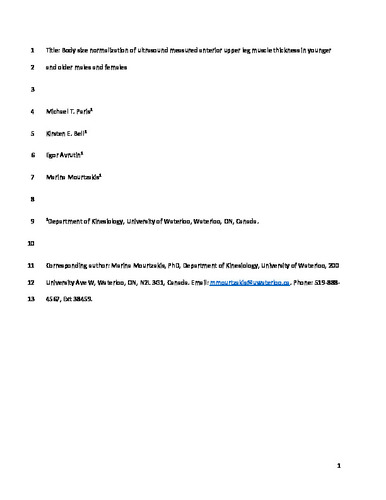| dc.contributor.author | Paris, Michael | |
| dc.contributor.author | Bell, Kirsten Elizabeth | |
| dc.contributor.author | Avrutin, Egor | |
| dc.contributor.author | Mourtzakis, Marina | |
| dc.date.accessioned | 2023-05-10 15:42:55 (GMT) | |
| dc.date.available | 2023-05-10 15:42:55 (GMT) | |
| dc.date.issued | 2022-01 | |
| dc.identifier.uri | https://doi.org/10.1038/s41430-022-01070-0 | |
| dc.identifier.uri | http://hdl.handle.net/10012/19439 | |
| dc.description | This is a post-peer-review, pre-copyedit version of an article published in European Journal of Clinical Nutrition. The final authenticated version is available online at: https://doi.org/10.1038/s41430-022-01070-0 | en |
| dc.description.abstract | BACKGROUND: Ultrasound measurements of the anterior upper leg muscle thickness are often used to quantify muscle mass; however, the ideal normalization approach is unclear. Our primary objective was to examine how the anterior upper leg muscle thickness scales with indices of body size in younger and older adults. Our secondary objectives were to examine how normalization with body size alters the identification of low muscle thickness and associations with strength and physical function.
METHODS: Younger (<45 years) males (n = 38) and females (n = 24) and older (≥60 years) males (n = 53) and females (n = 24) were evaluated for anthropometrics and anterior upper leg muscle thickness. Allometric models were used to examine how body size metrics scale with anterior upper leg muscle thickness. A subset of older males was evaluated for strength and function.
RESULTS: Weight and BMI scaled with anterior upper leg muscle thickness with coefficients less than 1 (0.58 to 0.82, r2 = 0.15 to 0.31, p < 0.05) for both younger and older males and females. Compared to absolute anterior upper leg thickness, normalized indices identified a greater proportion of older adults with low muscle thickness (p < 0.05). Absolute muscle thickness provided stronger associations with strength compared to weight normalized indices.
CONCLUSIONS: Scaling exponents less than 1 for weight and BMI for the anterior upper leg muscle thickness indicate that allometric normalization is the ideal approach to develop body size independent metrics. However, allometric normalization of muscle thickness increases the proportion of older adults classified as low muscle mass but decreased the associations with strength. | en |
| dc.language.iso | en | en |
| dc.publisher | Nature Publishing Group | en |
| dc.relation.ispartofseries | European Journal of Clinical Nutrition; | |
| dc.subject | ultrasound | en |
| dc.subject | body composition | en |
| dc.title | Body size normalization of ultrasound measured anterior upper leg muscle thickness in younger and older males and females | en |
| dc.type | Article | en |
| dcterms.bibliographicCitation | Paris, M. T., Bell, K. E., Avrutin, E., & Mourtzakis, M. (2022). Body size normalization of ultrasound measured anterior upper leg muscle thickness in younger and older males and females. European Journal of Clinical Nutrition, 76(7), 958–963. https://doi.org/10.1038/s41430-022-0107 | en |
| uws.contributor.affiliation1 | Faculty of Health | en |
| uws.contributor.affiliation2 | Kinesiology and Health Sciences | en |
| uws.typeOfResource | Text | en |
| uws.peerReviewStatus | Reviewed | en |
| uws.scholarLevel | Faculty | en |

